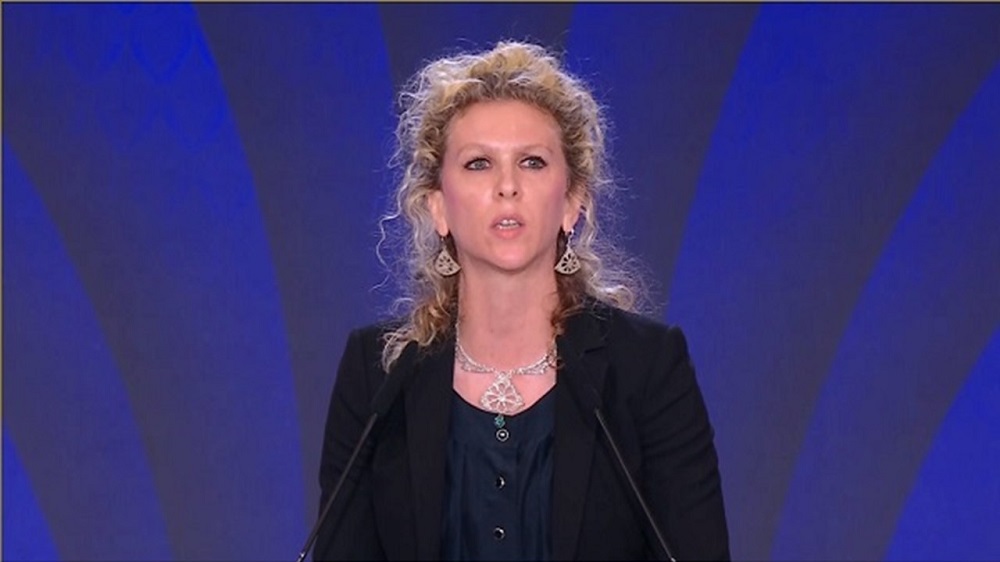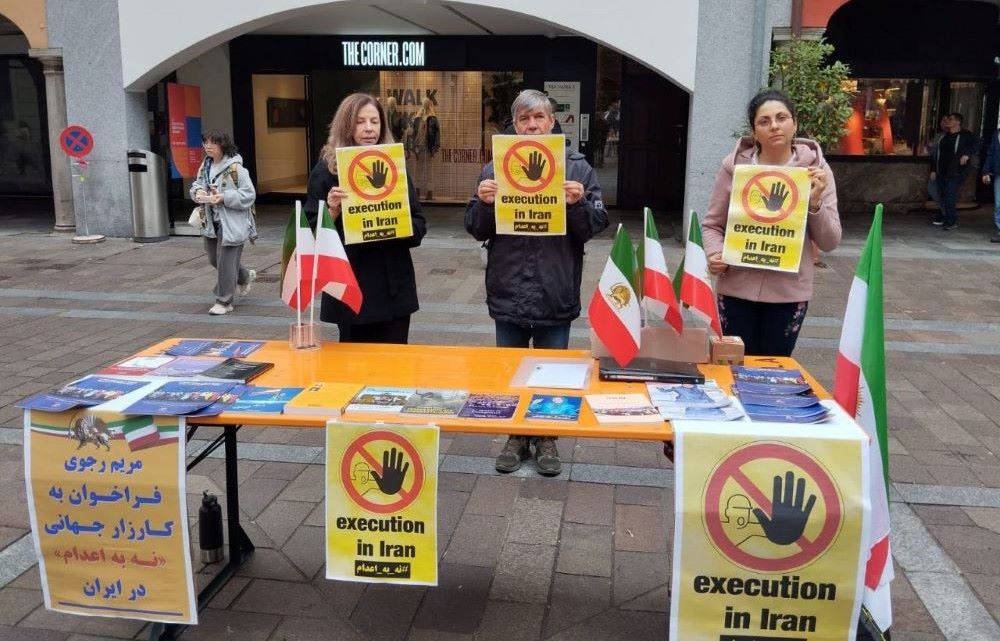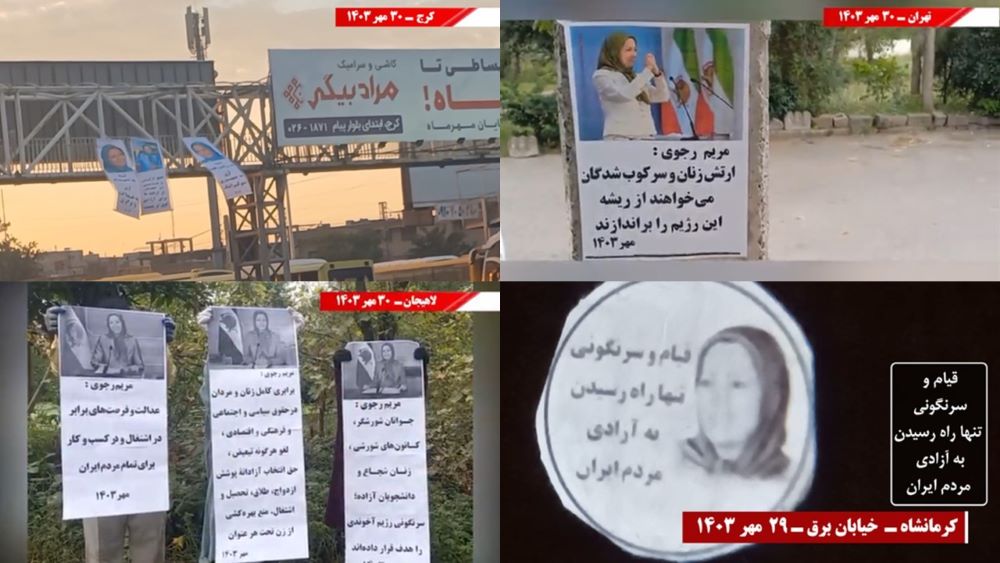
Irene Victoria Massimino Kjarsgaard (Argentina), Former Rapporteur of the High Criminal Court of Buenos Aires Province, addressed the third day of the Free Iran World Summit on July 3, 2023. The summit was under the title: Prosecute Iran’s Regime Leaders for Crimes Against Humanity, Genocide.
Irene Victoria Massimino Kjarsgaard: Iranian State Officials’ Impunity is A Crime by Itself
The script of the full speech of Ms. Irene Victoria Massimino Kjarsgaardfollows:
Thank you. I am filled with humility after seeing these videos of the victims and survivors of the 1988 massacre. It’s a huge responsibility for me to speak at this moment, so I thank you all for this opportunity.
Good afternoon to everyone, distinguished guests, colleagues, panelists, friends, who I now can call friends for the few hours we spent together. Dear Maryam, Madame Maryam Rajavi, what an honor for the women of the world to see you in this leadership position, a strong, intelligent, a woman of character, so thank you.
I wish you all the best, and I know that you will succeed. Thank you very much to all of the organizers for this relevant international conference. Thank you, especially for the NGO Justice for the Victims of the 1988 Massacre, who gave me the honor today to be present and to have the opportunity to speak.
I would also like to express my solidarity and my condolences to the victims and relatives of the victims of Iran’s past and current regimes. I also want to express my most profound admiration for the men and women, their courage and strength, who publicly oppose and continue to oppose Iran’s autocratic regime and who claim a better future of freedom and peace in Iran.
The barbaric acts of today have concerning similarities with the 1988 massacre, which started with Ayatollah Khomeini’s order in July of that year to execute an estimated of 30,000 people, political prisoners, in Iranian jails. The 1988 massacre was carried out by the current president of Iran, Ebrahim Raisi, one of the four members of the ‘Death Committee’ for Tehran at that time.
The lack of accountability for the perpetrators of the 1988 massacre and of justice and recognition for the victims is directly linked to the institutional crimes committed today. Impunity is a crime by itself.
A few years earlier, between 1976 and 1983, as my colleague and conational said previously, in my own country, Argentina, a civil-military dictatorship unfolded into the bloodiest of six dictatorships Argentina suffered during the 20th century. The links between the crimes committed by the military juntas during those years and the 1988 massacre in Iran have unfortunately common characteristics.
In both cases, laws were passed to legitimize institutional violence. In Argentina, the military juntas officially called for a national reorganization process. In Iran, a fatwa was passed ordering the execution of imprisoned opposition. In both cases, the number of victims of the authoritarian regimes rose to approximately 30,000 individuals. And in both cases, forced disappearances became a widespread atrocity.
When I went to the displays that you beautifully put up today, I looked at the images, and the photos, and I read the different writings below the photos and I thought that the practices were similar. There were 14, 16, and 18-year-old children executed by the regime in Iran. Most amounts of victims of the Argentine dictatorship were between the age of 18 and 35, but a lot of them were younger than that.
They went down to 16, students in high school, for example, for claiming a cheaper ticket on the bus to go to school. The crime of enforced disappearance became a common practice not only in Argentina but in many countries of South American dictatorships in the 1970s and 1980s.
Moreover, the intelligence agencies of the military dictatorships of Chile, Argentina, Uruguay, Bolivia, Paraguay, and Brazil, which formed the sadly worldwide known Plan Condor, enhanced the crime of enforced disappearances. The Plan Condor became an illicit association that coordinated efforts to enforce the disappearance of political dissidents.
Fortunately, the Argentine courts have ruled and continue to rule today that the political crimes committed in Argentina amount to crimes against humanity, but also to genocide, because a sufficient part of the national Argentine group was destroyed during that time. The similarities between Iran and Argentina continue, and I hope one day we can achieve justice for you all.
The category of enforced disappearance is not the simple result of laws or agreements. Rather, it emerges from a complex historical and social discourse constructed by an immense network of academics, international institutions, formal and informal pedagogy, the media, and national and transnational NGOs, which fought against institutionalized murder, kidnapping, illegal detention, and deprivation of liberty, amongst other serious crimes.
There are too many characteristics I would like to highlight about this complex historical and legal concept of enforced disappearance. From a humanitarian perspective, and you know better than I do, this crime constitutes a permanent longing for the victim’s family.
Resumen de mi presentación en #FreeIranWorldSummit2023 https://t.co/TK4r22rqLx
— Irene Victoria Massimino Kjarsgaard (@ivmassiminok) July 9, 2023
The crime of enforced disappearance has no closure and allows for no closure. The sufferings of the relatives exist for as long as the disappearing exists. A Sri Lankan anthropologist defined enforced disappearance as a mode of displacement, where the disappearance is often the ultimate goal. Indeed, the disappearance is one of the most insidious forms of violence, since it seeks the obliteration of the body and does not allow concluding the process of psychological closure.
From a legal perspective, the crime of enforced disappearance has a unique characteristic, uncommon to many crimes. It is an ongoing crime. It produces effects for as long as the disappearance exists. A permanent or ongoing crime is constituted by an unlawful prolonged action without interruption in time. In Iran, this crime started in 1988, and it’s not over.
Moreover, like other crimes of human rights violations, the crime of enforced disappearance is not defined by a particular action, but as the continuous absence of documents and bodies, dead or alive, related to the victims. The crime of enforced disappearance creates an overwhelming absence, and it’s precisely this overwhelming and constant absence that defines it.
Disappearance is a forensic concept defined by and for the legal sphere. Thus, the key aspect of the legal definition of disappeared lies in the permanent and continuous absence of the body and of the documentation of its whereabouts. This permanence allows the triggering of jurisdictions and laws that otherwise would be difficult to finally apply to end the vicious circle of impunity that once again is feeding violence in Iran.
For 35 years, families and friends of the Iranian disappeared have been longing for the bodies of their loved ones, for documentation and information that would allow them to know exactly what happened to them, and where they are. The psychological trauma provoked by the permanent presence of the absent body is overwhelming. We must stop this cycle by supporting any judicial process of accountability.
Irene Victoria Massimino Kjarsgaard (#Argentina), @ivmassiminok:
— Iran Freedom (@4FreedominIran) July 22, 2023
The barbaric acts of today have similarities with the #1988Massacre, which started with Khomeini’s order in July of that year to execute an estimate of 30,000 political prisoners in Iranian jails. pic.twitter.com/zMAWFRtkLK
I have often reiterated that accountability as a form of justice represents the beginning of the healing process. It gives victims a formal voice and empowers them to speak out, as we have seen well explained by our colleague here in the Swedish case. It helps reconstruct the truth and build the historical and individual collective memory. It is an important form of reparation by itself. It’s an essential part of the element of the mechanism of prevention and triggers other forms of reparation: memory and truth.
Moreover, accountability also identifies perpetrators helping to destroy frameworks of criminal power. Unfortunately, perpetrators are not always available for punishment. However, this should not be a deterrent in any justice-seeking process. Justice is essential for the victims, besides being a fundamental right. Without justice, we live in a permanent state of denial.
The international community as a whole and countries which have accepted its fundamental principles and values, such as my own, Argentina, which has a rich history and presence of accountability for atrocity crimes, as I mentioned, are obliged to support, encourage and facilitate any type of justice process for victims of Iran’s 1988 massacre. In the absence of justice, the threat to peace and security is latent.
Impunity reigns and the risk of new human rights violations and atrocity crime is perpetrated. Reports and statements by international organizations and countries are insufficient and they fill the desks of bureaucrats. True judicial accountability is the only way to provide help in the construction of a free, peaceful, and democratic Iran.
I want to end with a wish to conclude this presentation, that you all can go back to a peaceful and free Iran and that the Iranians in Iran can live in peace. I hope I can accompany you on this journey. Thank you.
1. @ivmassiminok draws parallels between the #1988Massacre in Iran and the crimes committed by military juntas in Argentina during the same period. #FreeIran2023 https://t.co/FXXFvJDlnC
— Iran Freedom (@4FreedominIran) July 3, 2023





